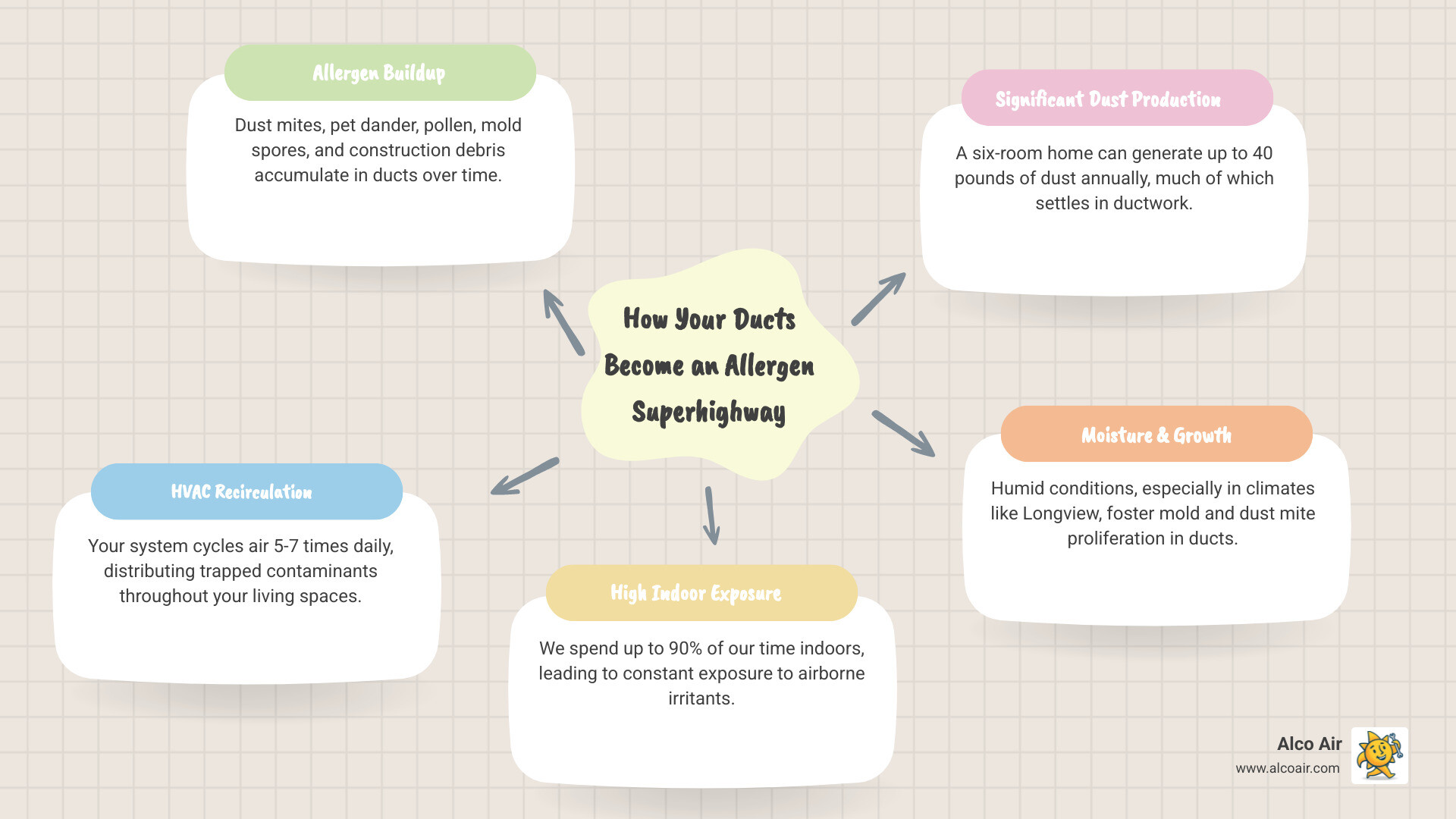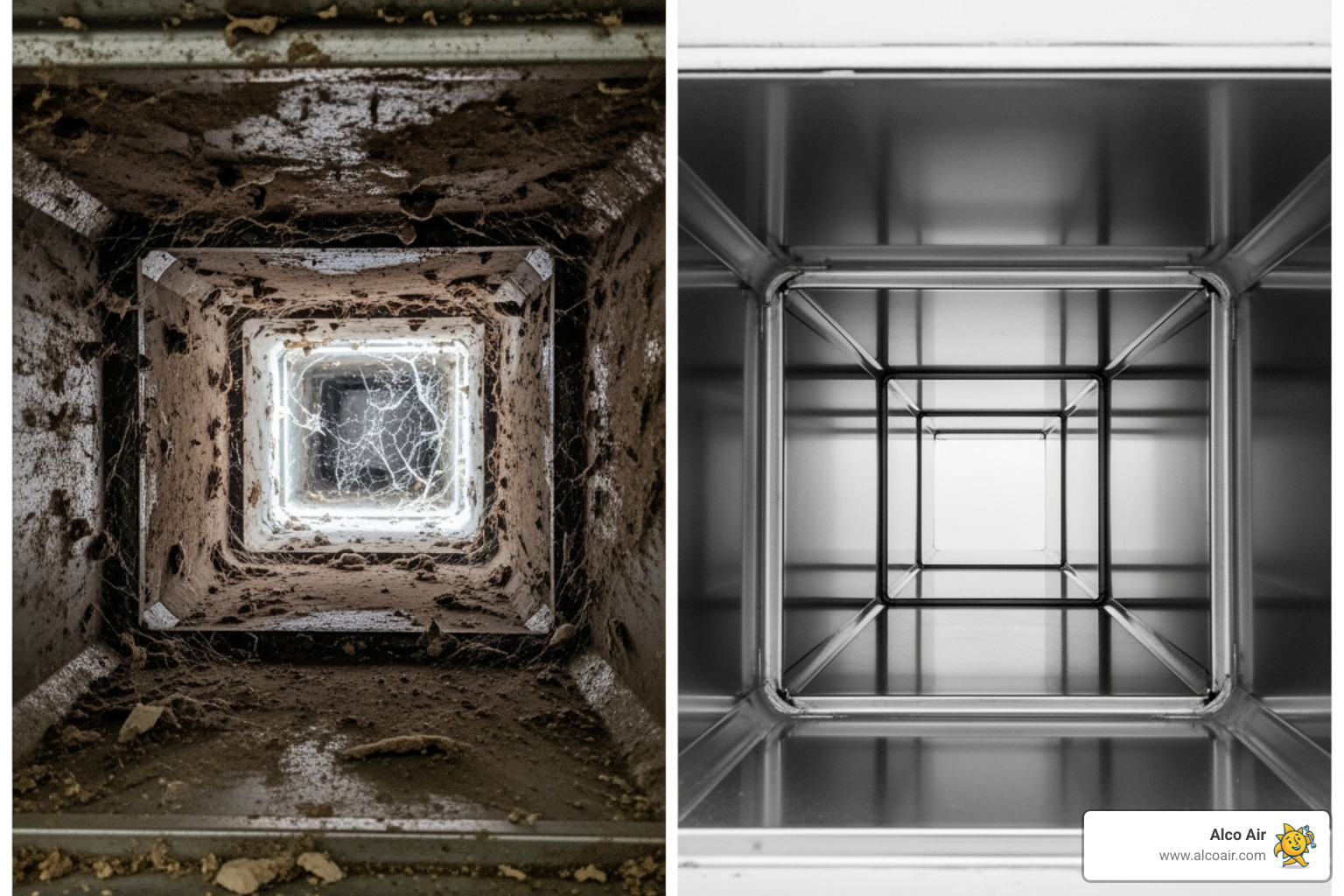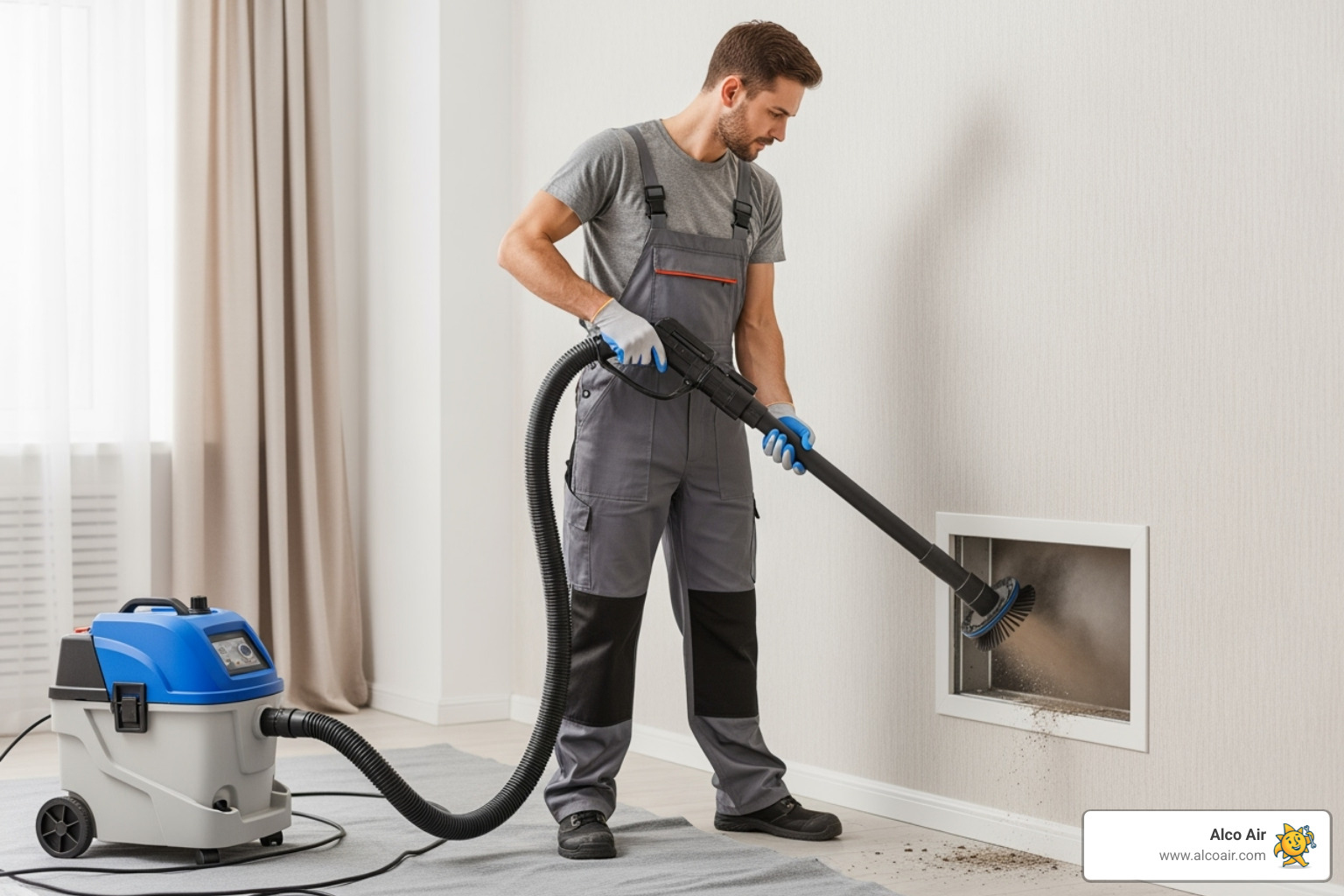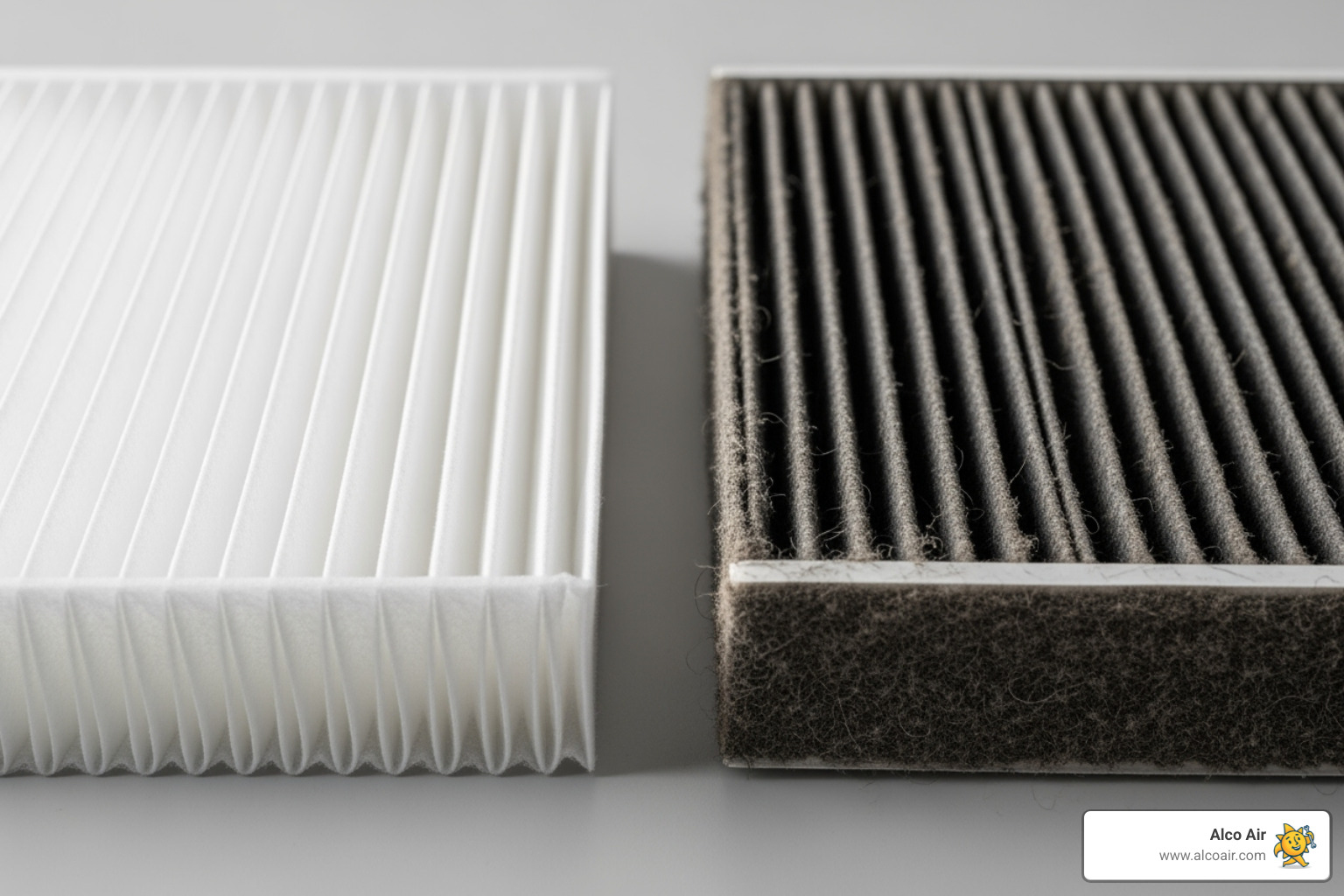Why Indoor Air Quality Could Be Your Hidden Allergy Trigger
Duct cleaning for allergies can be a game-changer for millions of Americans who suffer from year-round allergy symptoms. If you’re sneezing, coughing, and dealing with itchy eyes more often at home than outdoors, the problem might be lurking inside your walls.
Quick Answer: Benefits of Duct Cleaning for Allergies
- Removes accumulated allergens like dust mites, pet dander, pollen, and mold spores
- Improves indoor air quality by eliminating contaminants that circulate through your HVAC system
- Reduces allergy symptoms especially for those with dust, pet, or mold allergies
- Prevents cross-contamination of allergens throughout your home
- Works best when done professionally every 2-3 years for allergy sufferers
Here’s the reality: we spend up to 90% of our time indoors, yet indoor air can be significantly more polluted than outdoor air. Your HVAC system recirculates the air in your home 5 to 7 times per day, which means any allergens trapped in your ductwork get blown throughout your living space repeatedly.
The average person takes about 20,000 breaths per day, and a six-room home can create up to 40 pounds of dust each year – much of which ends up in your air ducts. When your heating or cooling system kicks on, these accumulated allergens get distributed to every room, potentially triggering symptoms like sneezing, congestion, itchy eyes, and respiratory issues.
For allergy sufferers in Longview’s humid climate, this problem can be especially challenging. Moisture in ductwork creates ideal conditions for mold and dust mites to thrive, making professional duct cleaning a crucial step in managing indoor allergies.
Why Your Air Ducts Are an Allergen Superhighway
Think of your home’s air ducts as a highway system – except instead of cars, they’re carrying dust, pollen, and other allergens to every room in your house. Every time your heating or cooling system turns on, it’s like rush hour for allergens.
Here’s what makes this so problematic: your HVAC system circulates air throughout your home 5 to 7 times per day. If your ducts are dirty, that means allergens get a free ride to your bedroom, living room, kitchen – everywhere you spend time. It’s no wonder your symptoms might feel worse indoors than outside!
Dust accumulation in ductwork happens faster than most homeowners realize. Statistic about 40 pounds of dust per year in a six-room home? A significant portion of that dust ends up in your air ducts, where it sits and waits for the next time your system kicks on.
Moisture issues make the problem even worse, especially here in Longview’s humid climate. When condensation builds up in your ductwork, it creates the perfect environment for mold and bacteria to grow. These biological contaminants don’t just sit there quietly – they release spores that get blown throughout your home every time the air circulates.
What’s Hiding in Your Ductwork?
You might think it’s just dust bunnies hiding in your air ducts, but the reality is much more complex. Your ductwork can harbor a surprising variety of allergens and contaminants that directly impact your breathing and comfort.
Dust mites are among the most common culprits. These microscopic creatures love warm, humid environments and feast on the dead skin cells we naturally shed. Their waste products are potent allergens that can trigger sneezing, congestion, and itchy eyes.
Pet dander is another major offender. Those tiny flecks of skin, hair, or feathers from your beloved pets are incredibly lightweight, which means they stay airborne longer and easily get sucked into your ductwork. Even if you vacuum regularly, pet dander in your ducts keeps recirculating.
Pollen finds its way into your ducts even when you keep windows closed. It hitchhikes on your clothes, shoes, and pets, eventually settling into your HVAC system where it can trigger seasonal allergy symptoms year-round.
Perhaps most concerning is when mold, mildew, or bacteria growing in your ductwork takes hold. These biological contaminants thrive in dark, moist environments and can cause serious respiratory issues. Their spores are easily inhaled and can trigger both allergic reactions and asthma attacks.
Construction debris becomes a problem after any home renovation project. Sawdust, drywall particles, and other construction materials can get trapped in your system for months or even years after the work is completed.
Volatile Organic Compounds (VOCs) from paints, cleaning supplies, and furnishings can also accumulate in ductwork. While not traditional allergens, these chemical vapors can irritate sensitive respiratory systems and worsen allergy symptoms.
Telltale Signs Your Ducts Are Worsening Your Allergies
Your body is often the best detective when it comes to identifying duct-related allergy problems. Worsening symptoms indoors is the biggest red flag – if you’re sneezing more at home than outside, your ducts might be the culprit.
Visible dust on vents is another clear indicator. When you see dust buildup around your supply and return vents, it means particles are actively being blown into your living spaces. This is especially noticeable on the vents closest to your HVAC system.
Musty or stale odors coming from your vents often signal mold or mildew growth inside your ductwork. These smells are typically most noticeable when your system first turns on after being off for a while.
Recent home renovations can dramatically increase the allergen load in your ducts. Construction dust and debris easily enter open ductwork during projects, and standard air filters aren’t designed to catch all these particles.
If you’ve welcomed new pets into your home, you might notice increased allergy symptoms as pet dander accumulates in your ductwork faster than your current cleaning routine can manage.
Unexplained respiratory issues like persistent headaches, fatigue, or breathing difficulties that seem worse at home could indicate that duct cleaning for allergies might be necessary. While these symptoms can have many causes, contaminated ductwork is often an overlooked factor in poor indoor air quality.
The Solution: Professional Duct Cleaning for Allergies
If those warning signs sound all too familiar, don’t worry – there’s hope! Duct cleaning for allergies isn’t just a Band-Aid solution; it’s a comprehensive approach that can genuinely transform your home’s air quality and your daily comfort.
When we talk about professional duct cleaning, we’re not referring to someone with a shop vacuum making a quick pass at your vents. Real duct cleaning for allergies is like giving your home’s respiratory system a deep, therapeutic cleanse.
The gold standard in our industry is called the source removal method, and it’s honestly pretty impressive to watch. Picture this: we create a powerful negative air pressure system throughout your entire ductwork – think of it as putting your ducts under a gentle but thorough suction. While this specialized vacuum system is working, our technicians use various agitation tools like rotary brushes and air whips to carefully dislodge years of accumulated dust, pet hair, and other allergens from every surface inside your ducts.
The beauty of this process is that nothing gets blown back into your home. As soon as debris is loosened, it’s immediately pulled into our HEPA-filtered vacuum systems. It’s like having a containment field that ensures all those allergens leave your home for good.
But here’s what really sets professional cleaning apart: we don’t just clean the obvious parts. A thorough job includes your supply and return air ducts, registers, grilles, diffusers, heat exchangers, cooling coils, condensate drain pans, fan motor and housing, and the air handling unit housing. Every component that touches your home’s air gets attention.
The Surprising Benefits of Duct Cleaning for Allergies
Most people expect duct cleaning for allergies to help with their sneezing and watery eyes – and it absolutely does! But our clients are often amazed by the additional benefits that come along for the ride.
Removes built-up allergens is obviously the main event. We’re talking about physically extracting dust mites, pet dander, pollen, mold spores, and other microscopic troublemakers that have been calling your ducts home. For allergy sufferers, this means fewer triggers floating around your living spaces every day.
Improves overall indoor air quality in ways you’ll actually notice. Beyond allergens, we remove general dust, debris, and even chemical residues that can make your air feel stale. Many clients tell us their home just feels “lighter” and more breathable afterward.
Here’s one that might surprise you: improves HVAC system efficiency. When your ducts are clogged with debris, your heating and cooling system works overtime trying to push air through those obstacles. Clean ducts mean better airflow, which often translates to lower energy bills. Who doesn’t love saving money while breathing easier?
Eliminates musty odors that you might not even realize you’ve gotten used to. That slightly stale smell that hits you when your system kicks on? Often, that’s mold, mildew, or bacteria that’s been growing in your ductwork. Professional cleaning, sometimes followed by sanitizing treatment, can make your home smell genuinely fresh again.
Finally, reduces strain on your furnace and AC. When your system doesn’t have to fight against clogged ducts, it experiences less wear and tear. This can extend the life of your equipment and save you from expensive repairs down the road.
Why Professional Cleaning is a Must for Allergy Sufferers
We get it – there’s something appealing about tackling home projects yourself. But when it comes to duct cleaning for allergies, the DIY approach is like trying to perform surgery with kitchen utensils. It’s just not going to get the job done effectively.
The equipment difference alone is staggering. While you might have a household vacuum and some brushes, professional teams use specialized equipment including high-powered negative air pressure systems, HEPA-filtered vacuums, and agitation tools specifically designed for duct interiors. Our vacuums can trap approximately 99.7% of particles sized 0.3 microns or larger – that’s smaller than most allergens.
Technician training and expertise matter more than you might think. Our NATE-certified technicians understand HVAC system mechanics, airflow dynamics, and proper cleaning protocols. They know how to clean thoroughly without damaging your expensive equipment or accidentally releasing more contaminants into your home.
Thoroughness and safety are where the real difference shows. DIY efforts can typically only reach visible registers and maybe a few inches into ducts. Meanwhile, professionals clean the entire system – main trunk lines, branch lines, return ducts, coils, fan motors, and housing. Plus, we protect your home and properly seal access points when we’re finished.
The inability of DIY to reach entire system is perhaps the biggest limitation. You might disturb surface dust (potentially making your allergies temporarily worse), but you can’t access the deep-seated contaminants that are the real problem.
For the most reliable results, look for NADCA certified professionals. NADCA certification ensures technicians are trained in the latest, most effective cleaning methods – exactly what you need for genuine allergy relief.
Beyond the Ducts: A Whole-Home Approach to Allergy Relief
While professional duct cleaning for allergies is a game-changer for many homeowners, it’s just one piece of the puzzle. Think of your clean ducts as laying a strong foundation – now you want to build on that success with smart daily habits that keep allergens from taking over your home again.
The truth is, allergens are persistent little troublemakers. They’re constantly finding new ways into your living space, whether it’s pollen hitching a ride on your clothes or pet dander floating through the air. But here’s the good news: with the right approach, you can stay ahead of them and maintain that fresh, clean air you’ll enjoy after your duct cleaning.
Your HVAC system works around the clock to keep you comfortable, so it makes sense to give it the support it needs. Regular maintenance isn’t just about preventing breakdowns – it’s about creating an environment where allergens simply can’t thrive. When you combine professional duct cleaning with consistent home care, you’re creating a powerful defense system against indoor allergies.
Key Maintenance Habits for Lasting Relief
The best part about maintaining your allergy relief? Most of these habits are surprisingly simple once you get into the rhythm. Let’s walk through the most effective ways to keep your indoor air clean and your symptoms at bay.
Changing your HVAC filters regularly is hands down the easiest win you can get. Your filter is like a bouncer at the door of your HVAC system, stopping unwanted particles before they can circulate through your home. We recommend you change your HVAC filters regularly (every 1-3 months), but if you have pets or severe allergies, you might need to swap them out even more frequently.
Not all filters are created equal, though. Using high-MERV or HEPA filters can dramatically improve your air quality. These upgraded filters are like trading in a chain-link fence for a fine mesh screen – they catch the tiny particles that basic fiberglass filters let slip through. HEPA filters are particularly impressive, trapping approximately 99.7% of particles sized 0.3 microns or larger in diameter. That includes most of the allergens that love to make your life miserable.
Vacuuming frequently with a HEPA-filter vacuum keeps allergens from building up in your carpets and furniture. Think of it as regular maintenance for your floors – you wouldn’t let dust pile up on your coffee table, so why let it accumulate in your carpet fibers? A vacuum with HEPA filtration ensures those particles stay trapped instead of getting blown back into the air.
Scheduling annual HVAC system tune-ups might seem like an extra expense, but it’s actually an investment in your health and comfort. During these visits, technicians clean components like coils and drain pans where moisture and allergens love to gather. It’s like giving your entire system a spa day – everything gets cleaned, checked, and optimized for peak performance.
Finally, controlling indoor humidity levels is crucial, especially here in Longview where our climate can get pretty sticky. Dust mites and mold are like teenagers at a pool party – they absolutely love humidity. Keep your indoor humidity below 50%, and these unwelcome guests will find your home much less appealing. Your air conditioner helps with this during the summer, but you might need a dehumidifier during those particularly humid months.
Frequently Asked Questions about Duct Cleaning and Respiratory Health
When people are struggling with allergies at home, they naturally have questions about whether duct cleaning for allergies can really help. After three decades of helping Longview families breathe easier, we’ve heard just about every concern and curiosity. Let me share the answers to the questions we hear most often.
How often should ducts be cleaned, especially for allergy sufferers?
This is probably the most common question we get, and honestly, it’s a smart one to ask. The timing really depends on your specific situation and how sensitive you are to allergens.
For most homes, the general guideline is every 3 to 5 years. That’s what industry experts recommend for maintaining good indoor air quality. But if you’re dealing with allergies, we usually suggest being more proactive.
For allergy sufferers, we typically recommend every 2 to 3 years. Think of it this way – you wouldn’t wait five years to deep clean your bedroom if you were sneezing every night, right? Your ducts deserve the same attention, especially since they’re working around the clock to circulate air through your home.
Now, some situations call for even more frequent cleaning. If you have pets that shed heavily, someone in the house smokes, or you’ve recently had renovations done, you might need cleaning more often. The same goes if you notice visible mold around your vents or if there’s been any water damage that affected your ductwork.
The key is paying attention to your symptoms. If your allergies seem to be getting worse at home, or if you’re noticing more dust around your vents, it might be time for a cleaning regardless of when your last one was done.
Can duct cleaning also help with asthma?
Absolutely, and this is something we see regularly with our clients. While duct cleaning for allergies isn’t going to cure asthma, it can definitely make a real difference in managing symptoms.
Here’s the thing – asthma can be triggered by the same airborne particles that cause allergic reactions. We’re talking about dust mites, pet dander, mold spores, and pollen – all the usual suspects that love to hang out in dirty ductwork.
When we thoroughly clean your ducts, we’re removing these triggers from the air you breathe every day. Many of our clients tell us they notice fewer asthma attacks or less severe symptoms after a professional cleaning. One customer even told us she hadn’t needed her rescue inhaler as often after we cleaned her ducts – though of course, everyone’s experience is different.
But here’s what’s important to remember: duct cleaning is just one piece of the puzzle. We always tell people to consult with their doctor about asthma management. Your physician knows your specific triggers and medical history, and they can help you create a comprehensive plan that might include duct cleaning along with other treatments.
Is the process safe for my home and HVAC system?
This is a great question, and I’m glad you’re asking it. When done by qualified professionals, duct cleaning is absolutely safe for both your home and your HVAC system. In fact, it’s actually beneficial for your system’s longevity.
Reputable companies take extensive precautions to protect your home. Our technicians use drop cloths to protect your flooring and furniture, and all our equipment is designed to contain dust and debris rather than spread it around your house. You shouldn’t have to worry about coming home to a mess.
As for your HVAC system, our NATE-certified technicians are specifically trained to understand how different types of ductwork and system components should be handled. We know the difference between flexible ducts and sheet metal, and we use the right tools and techniques for each. This isn’t a one-size-fits-all process.
One thing that gives our clients peace of mind is knowing that we properly seal any access points we create during the cleaning process. Your ductwork will be just as airtight as it was before we arrived – actually, often better since we can spot and address minor issues during the cleaning.
The truth is, a professional cleaning often helps your HVAC system run more efficiently. When your ducts aren’t clogged with debris, your furnace and AC don’t have to work as hard, which can extend their lifespan and save you money on energy bills.
Breathe Easier in Your Longview Home
If you’ve made it this far, you’re clearly serious about finding relief from those pesky indoor allergies. And honestly? That’s the first step toward breathing easier in your own home.
Duct cleaning for allergies isn’t just about removing dust – it’s about reclaiming your comfort. Think about it: when allergens like dust mites, pet dander, pollen, and mold spores are constantly circulating through your home, every breath becomes a potential trigger. But when you take control of your indoor air quality, something amazing happens. You start sleeping better, sneezing less, and actually enjoying time in your living spaces again.
The benefits we’ve covered – removing built-up allergens, improving overall indoor air quality, eliminating musty odors, and reducing strain on your HVAC system – all work together to create a healthier home environment. Combined with simple maintenance habits like changing filters regularly and controlling humidity, professional duct cleaning becomes part of a comprehensive approach to allergy relief.
Here in Longview, we understand the unique challenges our humid climate brings. Moisture in ductwork creates perfect conditions for mold and dust mites to thrive, making professional cleaning even more important for local families dealing with allergies.
At Alco Air, we’ve been helping East Texas families breathe easier for over 30 years. Our NATE-certified technicians know exactly what it takes to thoroughly clean your entire HVAC system – not just the visible parts, but the whole network where allergens love to hide. We’re so confident in our work that we back every service with a 100% money-back guarantee.
Your family deserves to feel comfortable in your own home. No more wondering if that sneeze is from outdoor pollen or something lurking in your ducts. No more waking up congested or dealing with itchy eyes every morning.
Ready to improve your indoor air? Learn more about our air duct cleaning services.















